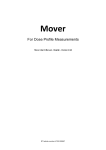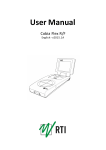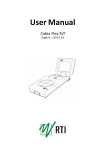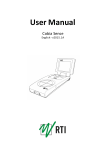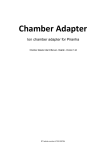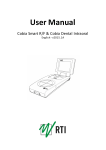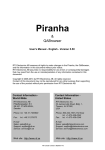Download Model G-7 Owners Manual
Transcript
Delmhorst Instrument Co. Model G-7 Owners Manual TABLE OF CONTENTS 2 INTRODUCTION 3 G-7 FEATURES 4 SECTION A – METER OPERATION 4 KEY SWITCH FUNCTIONS 4 SET UP MENU 4 TO ACCESS THE SET UP MENU 5 TEMPERATURE MODE 5 TEMPERATURE SCALE 6 %MC OFFSET 6 SET OFF TIMER 6 SET MENU TIMER 7 RESET MENU 8 CHECK METER CALIBRATION 8 CHANGE THE SET POINT 8 LOW BATTERY INDICATION 8 SELECT THE GRAIN 9 STORAGE MENU 9 9 10 10 TO ACCESS THE STORAGE MENU VIEW READINGS VIEW STATISTICS TO CLEAR MEMORY 11 SECTION B – TAKING A READING 11 TESTING GRAINS 11 TESTING GRAIN AND SEED IN BAGS 12 TESTING FESCUE AND OTHER GRASS SEEDS 1 of 16 12 TESTING HAY 13 SECTION C: FACTORS AFFECTING YOUR READINGS 13 GRAIN TEMPERATURE 13 MOISTURE DISTRIBUTION 13 SAMPLE SIZE 14 UNIFORMITY OF SAMPLE 14 CARE OF YOUR METER 15 SERVICE FOR YOUR METER 16 WARRANTY IMPORTANT NOTE: When turning G-7 “ON”, allow it to run through its entire initialization before pressing any keys. Any interruption to the initialization (“power up”)will result in a “Calibration Fail” when performing a calibration check. If this occurs, reset the meter, power it down, and then power it up properly. INTRODUCTION Thank you for purchasing the G-7 Grain Moisture Meter. The G-7 is a full-featured meter, that incorporates a double disc, pressure type electrode. The lower disc forms the base of a shallow cup in which the grain sample is placed. The upper electrode screws down over the sample cup. Both discs have sharp points that penetrate the seed coat and make contact with the interior of the grain. This system rests on a pressure plate that is mounted on a pretensioned calibrated spring, insuring uniformity of pressure from one test to another for optimum repeatability. The G-7 has been calibrated against well-conditioned samples whose moisture content was determined by standardized, approved methods. In these laboratory tests it was found that the readings are on the average within + 0.5% in the range 9 to 17 and + 1.0% in the range 17 to 23. The operating instructions for the G-7 are divided into three sections. Section A (Meter Operation) is a step-by-step guide to the different features and basic use of your moisture meter. Section B (Taking a Reading) contains information on how the meter is used for testing different grains. Section C (Factors Affecting your Readings) discusses various factors that may affect your readings. Please read the instructions carefully. If you require additional information, contact Delmhorst for assistance at 877-DELMHORST. 2 of 16 G-7 FEATURES ¾ Designed to check moisture levels in the following grains and hay: ¾ ¾ ¾ ¾ ¾ ¾ ¾ ¾ ¾ ¾ Barley ¾ Coffee ¾ Corn ¾ Flax ¾ Hay ¾ Oats ¾ Rapeseed ¾ Rough rice ¾ Rye ¾ Sorghum ¾ Soybeans ¾ Wheat Nominal Range: 9% - 30% MC depending on grain Built-in temperature correction User programmable offset Stores up to 150 readings Adjustable set point indicator Digital readout Includes (1) 9-Volt Alkaline Battery Proven microcontroller circuit One year warranty 3 of 16 SECTION A – METER OPERATION KEY SWITCH FUNCTIONS #1 – ON/OFF Turns the meter on and off. The G-7 has an automatic shut off feature, which turns the meter off after 4 minutes of either LOW readings only or no key activity. The 4-minute timer is user-adjustable. #2 – ENTER The ENTER key accepts a selection you make for the various functions made available through the menus. This key also stores displayed reading in memory. NOTE: If you do not press the ENTER key to execute a particular function, the selection will not be accepted, and the display will return to the main menu. #3 UP Allows you to scroll up the menu options #4 DOWN Allows you to scroll down the menu options SET UP MENU The set up menu is accessed by using the UP/DOWN keys. Within the set up menu are a number of preferences you may set before using the meter. Below is a description of those functions. TO ACCESS THE SET UP MENU: ¾ Press the UP/DOWN key until the display reads Setup Menu? ¾ Press ENTER The following setup functions are accessed in this order by pressing the UP key. These instructions assume that you have already accessed the Setup Menu as described above: 4 of 16 TEMP. MODE – The G-7 defaults to a temperature of 80°F. As grain temperature increases, indicated moisture content rises. Lower grain temperatures result in lower indicated moisture content. The temperature modes are: AUTOMATIC: A built-in temperature sensor measures the temperature of the grain sample. Let the grain sample remain in the sample cup for at least 5 minutes prior to taking a reading to allow the meter to correctly read the grain temperature. The meter will then display a temperature-corrected reading. MANUAL: Allows you to manually input the grain temperature as taken with an external thermometer or temperature system. After the temperature is input, the meter will display a temperature-corrected reading. Do not use the manual temperature mode unless you are confident that the temperature of the grain and the temperature of the meter are essentially the same. To change the temperature mode: ¾ Press the UP key until the display reads Temp Mode? ¾ Press the ENTER key to select a temperature mode. The meter will display the current temperature mode. ¾ To choose the temperature mode, press UP or DOWN keys to toggle, then ENTER to set. TEMP. SCALE ¾ Press the UP key until the display reads Temp Scale? ¾ Press the ENTER key to select the temperature scale (Fahrenheit or Celsius). ¾ Use the UP/DOWN keys to scroll forward or backward to the temperature scale desired. ¾ When scrolling in either direction, press ENTER to set the desired temperature scale. %MC OFFSET The %MC offset allows you to make a correction to the calibration of the meter in order to match the readings of the commercial grain elevator. The offset may be changed in increments of 0.1%. Before changing the offset, we recommend that you determine the average of at least three tests with the G-7 on the sample that was tested with the elevator meter. If you accept the elevator moisture meter as a standard, then adjust the %MC offset to match the elevator. 5 of 16 ¾ Press the UP key until the display reads Set %MC offset?. ¾ Press Enter to change the %MC offset. ¾ Use the UP/DOWN keys to scroll forward or backward to the offset value desired. ¾ When scrolling in either direction, press ENTER to select the desired offset. SET OFF TIMER The off timer allows you to change the meter’s automatic shut off in one-minute increments. The default setting is four minutes. If the meter reads only a LO reading, or no key has been pressed for four minutes, the meter will shut off automatically. ¾ Press the UP key until the display reads Set Off Timer? ¾ Press the ENTER key to enter this mode. The display will read “Change off timer to:” ¾ Press the UP/DOWN keys to select the desired increment of the timer. ¾ When scrolling in either direction, press the ENTER key to select the desired timer increment. SET MENU TIMER The menu timer allows you to change the amount of time in which a menu will timeout if no key is pressed. If no key is pressed in the amount of time set on the timer, the display will revert back to the main display. The menu timer is adjustable in increments of seconds. ¾ Press the UP key until the display reads Set menu timer? ¾ Press ENTER. The display will read “Change timeout to:” ¾ Use the UP/DOWN keys to scroll up or down to the desired timeout ¾ When scrolling in either direction, press ENTER to select the desired timeout. RESET METER This feature clears data memory and restores default parameters as follows: a) Grain = first in list (Barley) b) Temp. Mode = AUTO c) Temp. Scale = Fahrenheit d) Alarm Set Point = 15.0% e) All Offsets = 0 f) Menu Timer = 4 secs. g) Off Timer = 4 minutes 6 of 16 ¾ Press the UP key until the display reads Reset meter? ¾ Press ENTER to reset meter. The display will read “Memory storage is cleared. Meter is reset.” 7 of 16 The following functions are “stand alone functions” accessed by scrolling up or down the main menus. They are not part of the Setup Menu. CHECK METER CALIBRATION ¾ Press the UP or DOWN key until the display reads Cal test? ¾ Press the Enter key and the meter will go through the following sequence: “Measured nominal 14.0%” Then it will display “mc-14.0%.” Then it will read “Calibration Pass.” ¾ The meter is considered in calibration if the display reads 14.% ±0.5%. ¾ If the calibration does not pass, the sequence will end with a “Calibration Failed” display. CHANGE THE SET-POINT The set point is a user adjustable %MC value that will flash two arrows in an upward direction on the display screen if the meter reads higher than the selected value. The set point value may be changed in increments of 1.0%. ¾ Press the UP key until the display reads “Change Setpoint? ¾ Press ENTER. The display will read “Change Set Point Alarm To:” ¾ Use the UP/DOWN keys to scroll up or down to the desired set point. ¾ When scrolling in either direction, press ENTER to select the desired set point. LOW BATTERY INDICATION The meter displays “BATTERY LOW” when the battery voltage drops to approximately 5.8 volts. This is an indication that the remaining battery life is 1-1/2 hrs of continuous “on” time. SELECT THE GRAIN ¾ To change the scale, press the UP/DOWN key until the display reads “Select grain? ¾ Press ENTER to view the available grains. The meter will display “Change Grain to: ¾ Using the UP/DOWN keys to view the list of grains. ¾ Press Enter to select the desired grain. 8 of 16 Note: if you do not press the ENTER key after having reached your desired setting for any of the above selections, the meter will remain at the previous value prior to scrolling in either direction. STORAGE MENU The storage menu of the G-7 allows you to view any stored readings and display various statistics about those readings. It also allows you to clear the memory. TO ACCESS THE STORAGE MENU: ¾ Press the UP/DOWN keys until the display reads Storage Menu? ¾ Press ENTER The following functions are accessed in this order by pressing the UP key. These instructions assume that you have already accessed the Storage Menu as described above: VIEW READINGS After entering the storage menu, the display will immediately read “View Readings?” ¾ Press the ENTER key. The display will read “Select Batch:” and will list the name of one of the grains which has stored data. Note: If you have stored readings in “batches” for a number of different grains, you may select the grain to view by pressing the UP/DOWN keys until the desired grain is displayed. Then Press ENTER to select that grain. The meter will display the first reading of the selected batch. ¾ Press the UP key to scroll to the next stored readings. ¾ To scroll backward to a previously stored reading, press the DOWN key VIEW STATISTICS ¾ Press the UP key until the display reads “Statistics? ¾ If you have stored readings in more than one batch, the meter will display the current grain. To view statistics of another grain with stored readings, press the UP key until the desired batch is displayed. ¾ After you have selected the batch, press the ENTER key . The display will cycle through the following statistics: 9 of 16 1. Total: Avg.: The meter displays the total number of readings stored for the selected batch, and the average of those stored readings. 2. Std. Dev Co Var. The meter displays the standard deviation for the readings stored in the selected batch, and the co-efficient of variation. Definition of standard deviation and co-efficient of variance is as follows: Standard Deviation is a statistical parameter that gives the user, in one single figure, an indication of the “range” of readings that make up the AVERAGE. The lower the standard deviation, the closer all readings are to the average, indicating a uniform distribution of moisture content throughout the batch or load. Cov or co-efficient of variation is a term used to express the standard deviation as a percentage of the average. Its values are between 0.0 and 1.0 and again, a low COV would indicate a more uniform distribution of moisture. 3. Low High The meter displays the lowest and highest reading for the stored readings in the selected batch. TO CLEAR MEMORY: This function allows you to clear the stored readings, while maintaining all other settings such as grain, temperature, mode, etc. ¾ Press the UP key until the display reads: Clear Memory? ¾ Press the ENTER key. The display will read “Memory storage is cleared.” 10 of 16 SECTION B – TAKING A READING TESTING GRAINS ¾ Fill the sample cup with a single layer if grain or seed and place it on the pressure plate. ¾ Place electrode upper plate in position. Turn the electrode screw until you feel some resistance to turning it. Then turn it an additional one and a half turns. ¾ Press the “ENTER” key to store the displayed reading in memory. ¾ Turn the upper electrode counter clockwise, empty the cup and clean it with the brush in preparation for next test. TESTING GRAIN AND SEED IN BAGS ¾ Screw the optional #832 long pin prod into the H-3 handle and connect the electrode cable to the external connector on top of the moisture meter. ¾ Push the #832 prod into the seed bag and Press down on the electrode until the head of the screw which holds the pressure button, touches the palm of your hand. ¾ Press the “ENTER” key to store the displayed reading in memory. NOTES: Make several tests on various parts of the bag. Push the prod into the lower portion of the bag being tested, or into one of the bags on the bottom of the pile. You may stand on a bag and apply the electrode between your feet. When using the #832 Long Pin Prod, the following correction should be added to the meter readings: Oats, Corn, Wheat Barley 1.0% 1.5% Rye, Sorghum, Soybeans Rough Rice, Coffee 2.0% 2.5% TESTING FESCUE AND OTHER GRASS SEEDS ¾ Screw the optional #832 long pin prod into the H-3 handle and connect the electrode cable to the external connector on top of the moisture meter. ¾ Set the meter to HAY. ¾ Push the #832 prod into the seed and Press down on the electrode until the head of the screw which holds the pressure button, touches the palm of your hand. ¾ Press the “ENTER” key to store the displayed reading in memory. 11 of 16 NOTE: A reading of 12% normally indicates that the seed is at a safe level of moisture content. A reading of 14% indicates a borderline condition of moisture content. In this case, additional readings are recommended. TESTING HAY ¾ Set the meter to Hay. TESTING BALED HAY ¾ Screw the optional #830-2 10” prod into the H-3 handle and connect the electrode cable to the external connector on top of the moisture meter. ¾ Insert the probe into the bale. ¾ Press the “ENTER” key to store the displayed reading in memory. TESTING IN THE WINDROW ¾ Attach the #831 short pin prod to the H-3 handle and connect the handle to the external connector on top of the meter. ¾ Prepare a representative sample by collecting hay from various parts of the windrow. ¾ Place hay in a non-conductive container (such as a 5 to 10 gallon plastic pail) and apply the short pin prod to the hay. ¾ Press down on the electrode until the head of the screw which holds the pressure button, touches the palm of your hand. ¾ Press the “ENTER” key to store the displayed reading in memory. ¾ Mix the sample once again and take at least two more readings. Use the highest readings. When testing in the windrow, push down on the pressure button until the palm of your hand touches the screw that holds the key in place. The pressure button depresses a calibrated spring inside the handle. When the screw touches the palm of your hand, the pressure applied on the sample is 27 – 30 lbs., which closely simulates the pressure in a standard bale of hay. If you do not have the #831 short pin prod, squeeze a handful of hay around the tip of the 830-2 for an estimate of windrow moisture levels. For more detailed information about using the G-7 on hay, please call Delmhorst Instrument Co. at 877-DELMHORST. Or you may download any of the owner’s manuals for our hay moisture meters from our web site at www.delmhorst.com 12 of 16 SECTION C: FACTORS AFFECTING YOUR READINGS: GRAIN TEMPERATURE ¾ Wide differences may exist between the grain temperature and that of the instrument. Under such conditions, the temperature of the samples may change so that it becomes difficult to measure it accurately. MOISTURE DISTRIBUTION ¾ This condition prevails when grain is drying, especially when using heat or rapid circulation of air. Differences in moisture content are also found in different parts of the same field because some parts may mature at different times. Actual differences in moisture content can also be found in a single ear of corn – moisture usually being greater near the stalk. SAMPLE SIZE ¾ The G-7 tests a small sample and therefore its reading is directly related to the moisture content of the grain from where the sample was selected. ¾ If the initial two or three tests indicate uniform moisture content, there is no need to make additional tests on other samples. On the other hand, if the initial tests indicate considerable variations in moisture content among the various samples, we recommend that you test more samples in order to have a more accurate determination of the average moisture content, and the range of moisture present. UNIFORMITY OF SAMPLE ¾ When checking the operation of a dryer, select samples of grain from different locations to determine how well the drier is performing, since the drying rate may not be uniform throughout the grain. Also, when checking the moisture content of grain in a bin, it is necessary to select various samples from different parts of the bin and test them individually. In such cases it is very important to ascertain that there is no grain in any part of the bin with a moisture content too high for safe storage. ¾ It is more important to know the range and distribution of moisture in stored grain than it is to know the average moisture content, since an average may not reveal the presence of high moisture pockets. ¾ Moisture migration may result in an accumulation of moisture in the top layers of the grain. It is necessary, therefore, to take at least one sample from this area when checking the moisture content of grain in a bin. Proper use of a moisture meter will show when to ventilate a bin and when fans can be shut down. These tests can be made in a very short time. 13 of 16 CARE OF YOUR METER To keep your meter in good working order: ¾ Store your meter in a clean, dry place. The protective carrying case provided is an ideal storage place when the meter is not in use. ¾ Change the 9-Volt battery as needed. Continued use with a low battery may cause the meter to go out of calibration. ¾ Clean the meter with any biodegradable cleaner. Use the cleaner sparingly and on external parts only. Keep cleaner out of the external connector. ¾ Brush off excess material from the sample cup and upper electrode assembly after each use. ¾ Remove the battery if the meter will not to be used for one month or longer 14 of 16 SERVICE FOR YOUR METER ¾ Before sending in your meter we recommend you give one of our trained technicians a call. Many times troubleshooting can be taken care of over the phone. Call us at 877DELMHORST. ¾ Pack your meter securely. Enclose a purchase order or letter with a brief description of the problem. ¾ There is no need to call us for a return authorization number if you are within the U.S. Customers outside the U.S. must contact us for more specific instructions prior to returning a meter. ¾ Include your name, address, daytime phone and fax numbers or e-mail address. If you believe the meter is under warranty, please provide the original sales slip or invoice. ¾ Ship via UPS, Express Mail, Priority Mail or any overnight courier who provides prompt service. Do not use standard parcel post. ¾ Insure your instrument for its full value and ship prepaid. We are not responsible for damage in transit. ¾ We do not accept COD shipments or cover any incoming freight or duty charges on returned merchandise ¾ Turnaround time on repairs is approximately two weeks. ¾ We will call you with an estimate if you specifically request one, or if we determine that the meter may be too costly to repair. ¾ Non-warranty repairs will be returned via UPS/COD unless you have already established other payment terms. There is no COD service outside the U.S. To pay by credit card, include the card number and expiration date with your repair. We accept Visa, MasterCard, and American Express. ¾ Warranty repairs will be returned at no charge if shipped within the U.S. via UPS Ground Service. Freight charges for expedited services (i.e., Federal Express, UPS/2 Day, UPS/1 Day, etc.) are the customer’s responsibility and will be charged as per the above terms. 15 of 16 WARRANTY Delmhorst Instrument Co., referred to hereafter as Delmhorst, guarantees its G-7 meter for one year from date of purchase and any optional electrodes against defects in material or workmanship for 90 days. If, within the warranty period of the G-7, you find any defect in material or workmanship return the meter following the instructions in the “Service for Your Meter” section. This limited warranty does not cover abuse, alteration, misuse, damage during shipment, improper service, unauthorized or unreasonable use of the meter or electrodes. This warranty does not cover batteries, pin assemblies, or pins. If the meter or any optional electrodes have been tampered with, the warranty shall be void. At our option we may replace or repair the meter. Delmhorst shall not be liable for incidental or consequential damages for the breach of any express or implied warranty with respect to this product or its calibration. With proper care and maintenance the meter should stay in calibration; follow the instructions in the “Care of Your Meter” section. Under no circumstances shall Delmhorst be liable for any incidental, indirect, special, or consequential damages of any type whatsoever, including, but not limited to, lost profits or downtime arising out of or related in any respect to its meters or electrodes and no other warranty, written, oral or implied applies. Delmhorst shall in no event be liable for any breach of warranty or defect in this product that exceeds the amount of purchase of this product. The express warranty set forth above constitutes the entire warranty with respect to Delmhorst meters and electrodes and no other warranty, written, oral, or implied applies. This warranty is personal to the customer purchasing the product and is not transferable. Delmhorst Instrument Co. 51 Indian Lane East Towaco NJ 07082 877-DELMHORST www.delmhorst.com e-mail - [email protected] For 60 years Delmhorst has been the leading manufacturer of high quality moisture meters and thermo-hygrometers. Today we offer the innovative KIL-MO-TROL in-kiln monitoring system. We also offer a wide range of meters for a variety of applications including woodworking/lumber, agriculture, construction, paper, restoration, IAQ and flooring. ©2001, Delmhorst Instrument Co. Rev B. 04/05 Rev 9/05 16 of 16


















